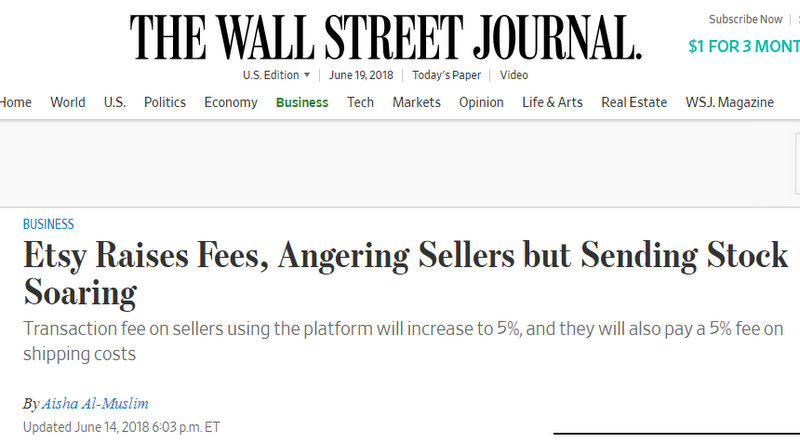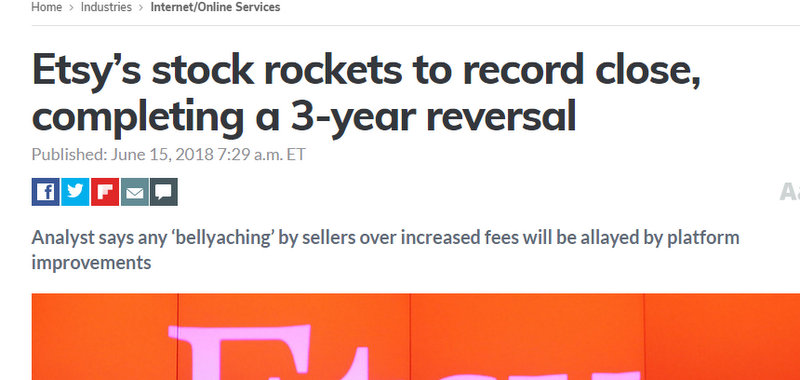A brief guide for the Etsy consumer
Etsy has been a great platform for the indie yarn community. It has functioned, in some ways, as an LYS for the whole world. Perhaps you’re ready to buy some yarn (because, you know, you’re breathing), but you aren’t sure exactly what you’d like. Well, just pop over to Etsy and a search for “green worsted weight wool” provides you with dozens of options and a chance of finding your new favorite Indie Dyer.
Periodically, however, Etsy would change its terms and a wave of dyers would leave, often setting up their own sites. A few months ago in particular, Etsy changed the way makers got paid, and I know many sellers who still remember with vivid emotion their decision to go at that time. It’s a considered business decision to leave. Because the fiber community is accustomed to finding dyers on Etsy, it’s hard to not be there. A dyer also has to have enough of a customer base to support their own site. If you search for “self-striping yarn” on Etsy, you’ll probably find my shop. If you search for it on google, I doubt I’ll show up on the first 10 pages.
Even with these considerations, the tipping point for me came a few weeks ago when Etsy announced they’d be taking control away from how and when sellers paid their bills, essentially holding our payments hostage. In one of the most intellectually insulting emails I’ve ever received (and I used to work in customer service), Etsy promoted the change as a benefit because no one has time to worry about pesky little things like controlling their own finances (especially all us crafty ladies), so just let Papa Etsy handle it for us. “Way simpler, right?” (Ok, so I’m adding the patriarchal spin, but it had the most Mad Men-esque tone of not stressing my pretty woman head out over money matters because the man who actually owns the bank account has it under control. I wonder if the email would have had the same tone if it were sent to a mostly male audience?)
This week, Etsy announced new changes, which, to me, makes it clear why it is time to leave. I’ll let the headlines spell it out for me:


According to a November article in the NY Times, there was a revolution at Etsy headquarters last summer where the long-time CEO was ousted as a result of an “activist investor,” and a new guy (always a guy, huh?) was installed who would focus more on making stock investors money.
He’s doing his job very well, apparently. Yay new guy!
The thing is, I have feelings about the stock market and how the American economy works in general. Rather strong feelings that resulted in me (and eventually my husband) leaving the workforce and committing to a life with about 1/3 of our previous income. In an oversimplified nutshell, I think the way we measure economic goodness is absurd (I’ll note that the Etsy stock price skyrocketed as a result of an announcement that they were raising fees. Not because they *actually* made more money or attracted new customers and sellers but because someone wrote a report with projections). I think the focus on made-up stock numbers results in massive inequality in this country and around the world, and prioritizes short-term wins over long-term stability, which has all sorts of bad consequences for people (especially poor people) and the environment on which we depend.
Ok. That was quite a diversion. But it took me 35 minutes of pre-tea braining to write, so I’m leaving it in. I won’t, however, include another paragraph about censored (filtered? personalized?) Google searches that made it impossible for me to find the headline I knew existed but couldn’t find (until my husband helped me. GAH!)
I really intended this post to be a primer for yarn buyers to understand how Etsy changes were affecting sellers, and thus might affect customers as well. Sellers are being put into a tough position and I know knitters are kind and just, so I’m hoping a little bit of info will help add understanding.
Etsy is raising its fees from 3.5% to 5% on transactions. This fee is on top of fees that sellers pay for credit card processing, and the fee they pay for listing each skein of yarn. In addition, they now have to pay that 5% fee on shipping costs as well. I think this is the bit that angers most sellers. I have always tried to ensure that customers pay the actual cost of shipping, rather than making the product seem cheaper but overcharging on shipping. In my case, I would have to tack on a 5% increase in the cost of postage (25 cents for $5). So, if you notice shipping charges going up, know that it’s because of guys in suits on Wall Street, not your friendly maker.
In my case, I’m leaving Etsy. I hope to provide you with a new shop link very soon (and new club signups). If you have any questions, please let me know. If I don’t know the answer, I’ll do my best to help find it.